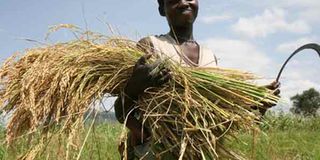ACT outlines key drivers of agricultural development

What you need to know:
- The sector also contributes at least 90 per cent to the country’s food security during the rainy season.
INTERVIEW. Tanzania’s agriculture sector employs at least 67 per cent of the country’s working population and contributes at least 30 per cent to the country’s gross domestic product (GDP). The sector also contributes at least 90 per cent to the country’s food security during the rainy season. However, the agricultural sector growth rate has been declining and between 2011 and 2015, the growth rate had increased by only 3.4 per cent. BusinessWeek reporter ELIAS MSUYA spoke to the Agricultural Council of Tanzania (ACT) director of policy and planning, Mr Timothy Mmbaga, who outlined key factors that contributed to the declining of agricultural sector growth in Tanzania. Excerpts:
Question: Since agricultural sector is the backbone of Tanzanian economy, how has ACT so far contributed in transformation of the sector in Tanzania?
Answer: Let me start by giving a crucial background of the potential Tanzania’s agricultural sector. In 1960 during movements for independence, the sector was contributing between 80 and 90 percent to the GDP, while currently it contributes only 20 percent.
Back in the days, Tanzania was the leading global producer of commercial crops like sisal and coffee.
But when we embarked on the free market economy and due to the falling of socialism and self-reliance policy, the sector started to decline. As the result, some of the research institutions were closed and majority of the researchers became jobless.
Following the scramble, the agricultural sector stakeholders in 1999 together had proposed establishment of a council whose role is to oversee the agriculture sector development.
The current ACT, formerly Chamber of Agriculture and Livestock was officially inaugurated by now the Retired President Benjamin Mkapa in 2000.
What is the general role of ACT?
Our role is to unite groups and associations of farmers, livestock keepers, suppliers, processors, transporters and researchers in order to push for improved economical and organizational environment of the sector. We are also the members of various forums such as Tanzania Private Sector Foundation (TPSF) and the Tanzania National Business Council (TNBC) which is chaired by the President of the United Republic. We are also the members of the Eastern Africa Farmers Federation (EAFF), the Southern Africa Federation agricultural Union and the Pan African Famers Federation.
The number of registered members has increased from 30 up to 170 since the ACT was established. Every year we hold a general annual stakeholders meeting to discuss various issues associated with agricultural sector. Among others, during the annual meeting the stakeholders generate various recommendations and submit them to the relevant government authorities for further implementations.
What are the achievements of the ACT in the agricultural sector?
There have been so many achievements including the introduction of the Kilimo Kwanza strategy. We were the first to introduce the idea and share with the government. We also introduved the idea of having the Tanzania Agricultural Development Bank (TADB) and also the Southern Agricultural Corridor of Tanzania (Sagcot), which is still doing well. Also as a result of our advocacy, the agricultural budget of the year 2010/11 rise up to 7 per cent and since that time The National service economic wing (Suma JKT) imported many tractors to stimulate agriculture.
Speaking of the current declining agricultural growth, what is the cause for the declining growth rate and what would be the impact?
Contribution of agricultural sector to GDP can remain unnoticed even if the sector grows at a good rate. This is because when you speak of the GDP, you speak of other key sectors’ contributions to the GDP.
After independence, the agricultural sector was contributing 90 percent to the GDP, but when other sectors were established, the agriculture started to lose its potentiality. We are now talking about contributions of other key sectors to the GDP such as Tourism, Mineral, Oil and Gas, Communications, among others. This is why the contribution of agricultural sector to the GDP remains unnoticed, but what is more importantly to ask ourselves is, at what rate is the agricultural sector growing?
Therefore, when we talk of a certain sector’s economic growth, we talk of its growth rate and not its contribution to the GPD. But, the Tanzania’s agricultural sector growth rate is currently declining and it contributes insufficient revenues to the GDP.
Despite the fact that other key sectors contribute sufficient revenues to the GDP compared to the agriculture sector, the sector employs majority of Tanzanian population. What should be done to ensure that Tanzanians benefit from the sector?
The government needs to increase the agricultural sector budget. It should account for at least 10 percent of the national budget.
Again, doubling of efforts is necessary to invest in irrigation agriculture system. The government needs to improve irrigation infrastructure in a bid to attract domestic and foreign investors to explore the investment opportunities in agricultural sector.
Another thing is, we need to make sure that we have enabling environment for business.




